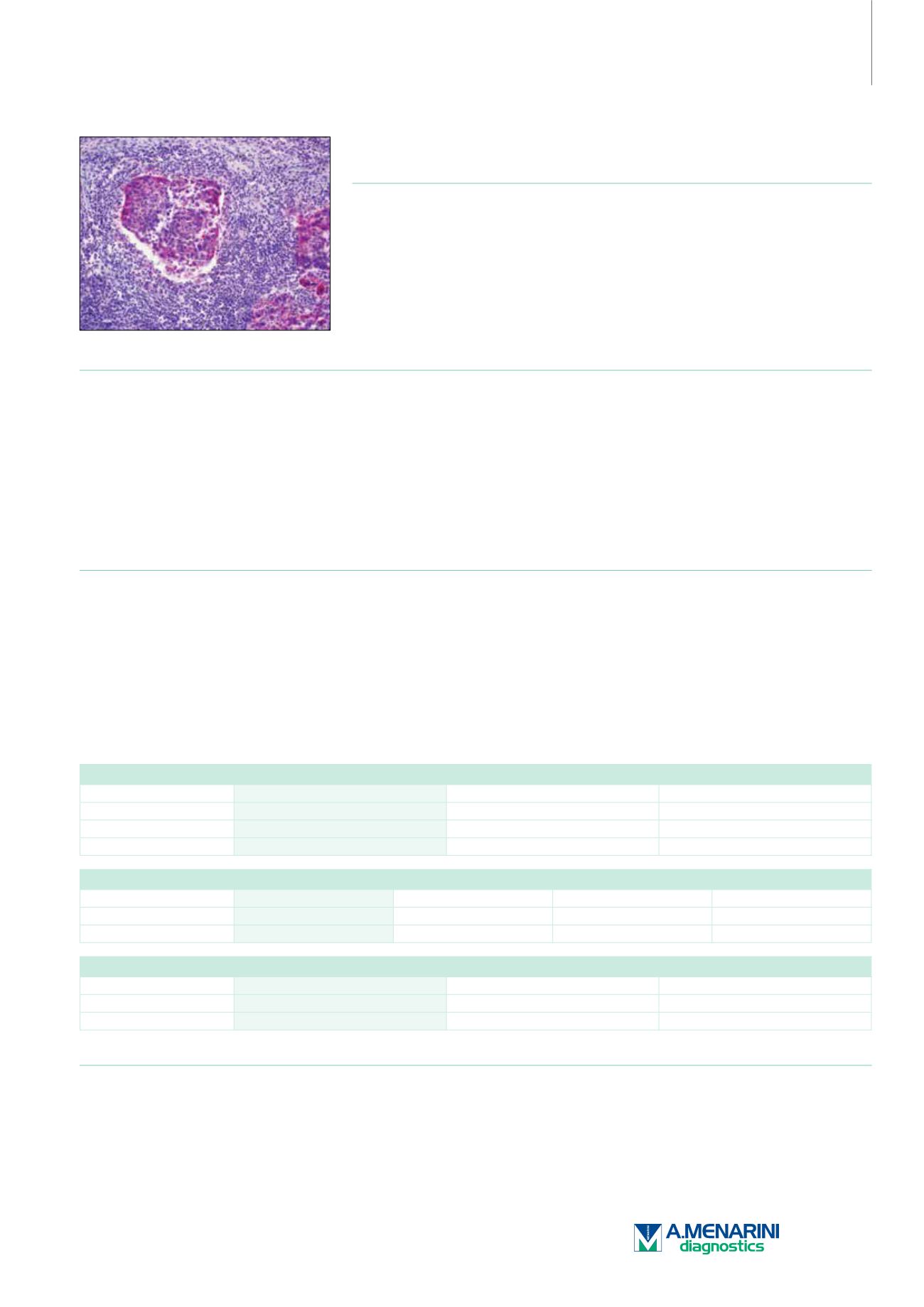
Advanced Solutions
for Advanced Pathology
Cytokeratin 17 (Ks 17.E3)
Mouse Monoclonal Antibody
Cat. No. Description
Volume
45198 IMPATH Cytokeratin 17 RTU M (Ks 17.E3)
50 Tests
44267 Cytokeratin 17 RTU M (Ks 17.E3)
7 ml Ready To Use
44555 Cytokeratin 17 0,1 M (Ks 17.E3)
100 µl liquid Concentrated
44556 Cytokeratin 17 1 M (Ks 17.E3)
1 ml liquid Concentrated
Product Specifications
Designation
IVD
Reactivity
Paraffin
Visualization
Cytoplasmic
Control
Breast, Cervix immature metaplasia
Stability
Up to 36 mo. at 2-8°C
Isotype
IgG
2b
Manual Protocol*
• Pretreatment: Heat Induced Epitope
Retrieval (HIER)
• Primary Antibody Incubation Time:
10-30min @ 25-37°C
• 2-step polymer detection
*Please refer to product insert for complete protocol.
ImPath Protocol*
• Dewax: Dewax Solution 2 (DS2)
• Pretreatment: Retrieval Solution pH 9.0
(TR1) 32min @ 98-103°C
• Primary Antibody Incubation Time:
10-90min @ 25-37°C
• HRP Polymer (Universal) or AP Polymer
(Universal) for 12 min
*Please refer to product insert for complete protocol.
Product Description
Cytokeratin 17 (CK 17) is expressed in epithelial cells of various origins, such as bronchial epithelial cells and skin appendages. It may be
considered as “epithelial stem cell” marker because CK 17 antibody marks basal cell differentiation. CK 17 can be useful when included in
a panel of antibodies against TTF-1, napsin A, CK 5&6, p63, and SOX-2 for diagnostic differentiation between lung adenocarcinoma (LADC)
and lung squamous cell carcinoma (SCLC), especially for poorly-differentiated lung carcinoma. CK 17 is expressed in SCLC much higher than
in LADC. In breast carcinomas, approximately 20% of patients show no expression of ER, PR and Her2, which are defined as triple negative
tumor. Eighty-five percent of the triple negative breast carcinomas immunoreact with basal cytokeratins including anti-CK 17. Also important
is that cases of triple negative breast carcinoma with expression of CK 17 show an aggressive clinical course. The histologic differentiation of
ampullary cancer, intestinal vs. pancreatobiliary, is very important for treatment. Usually anti-CK 17 and anti-MUC1 immunoreactivity represents
pancreatobiliary subtype whereas anti-MUC2 and anti-CDX-2 positivity defines intestinal subtype.
Cervix Neoplasia
CK 17
p16
CK 8
CIN I
+/-
+
-/+
CIN II
+
+
-/+
CIN III
+
+
+
Ampullary Cancer
CK 17
MUC1
CDX-2
MUC2
Intestinal Subtype
-
-
+
+
Ductal
+
+
-
-
Ampullary Carcinoma: Enteric vs. Ductal
CK 17
Hep-Par1
CDX-2
Enteric
-
+
-
Ductal
+
-
-/+
Reference
1. Regauer S, Reich O. Histopathology. 2007 Apr; 50(5):629-35.
2. Chu PG, Schwarz RE, Lau SK, Yen Y, Weiss LM. Am J Surg Pathol. 2005 Mar; 29(3):359-67.
3. Cohen-Kerem R, Madah W, et al. Ann Otol Rhinol Laryngol. 2004 Oct; 113(10):821-7.
4. Martens JE, Arends J, et al. Anticancer Res. 2004 Mar-Apr; 24(2B):771-5.
103


